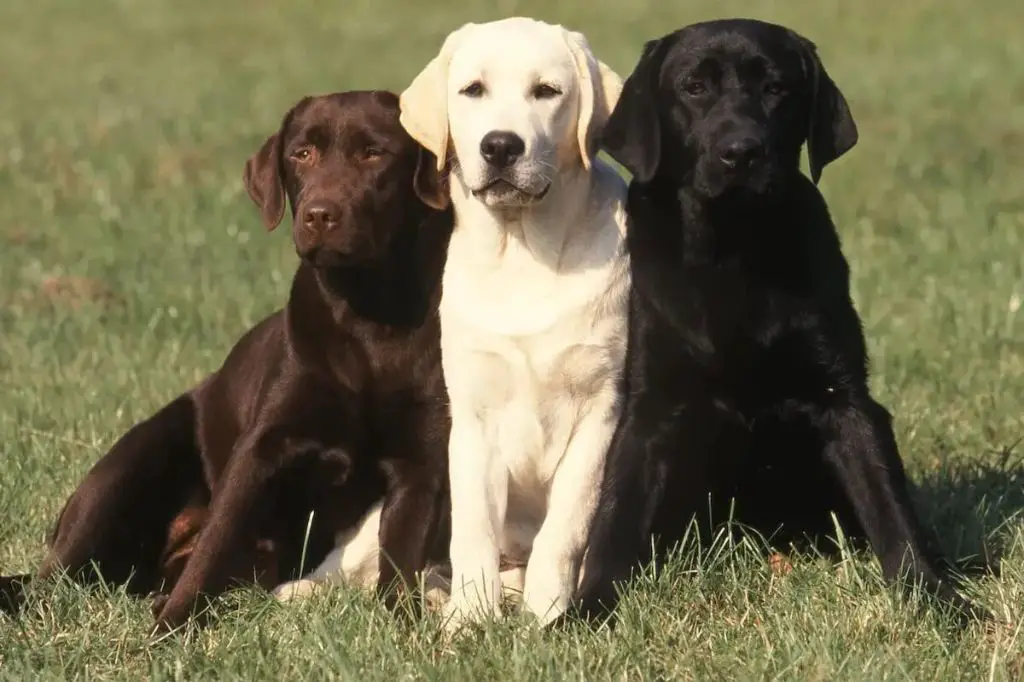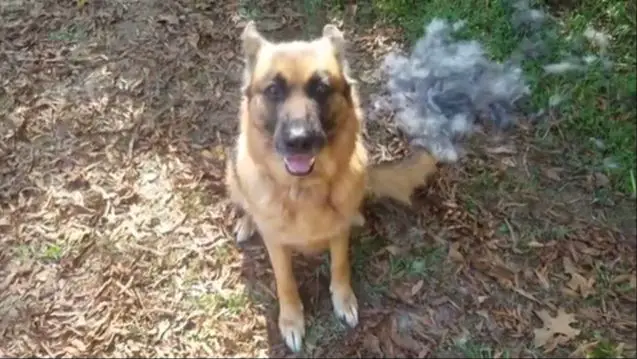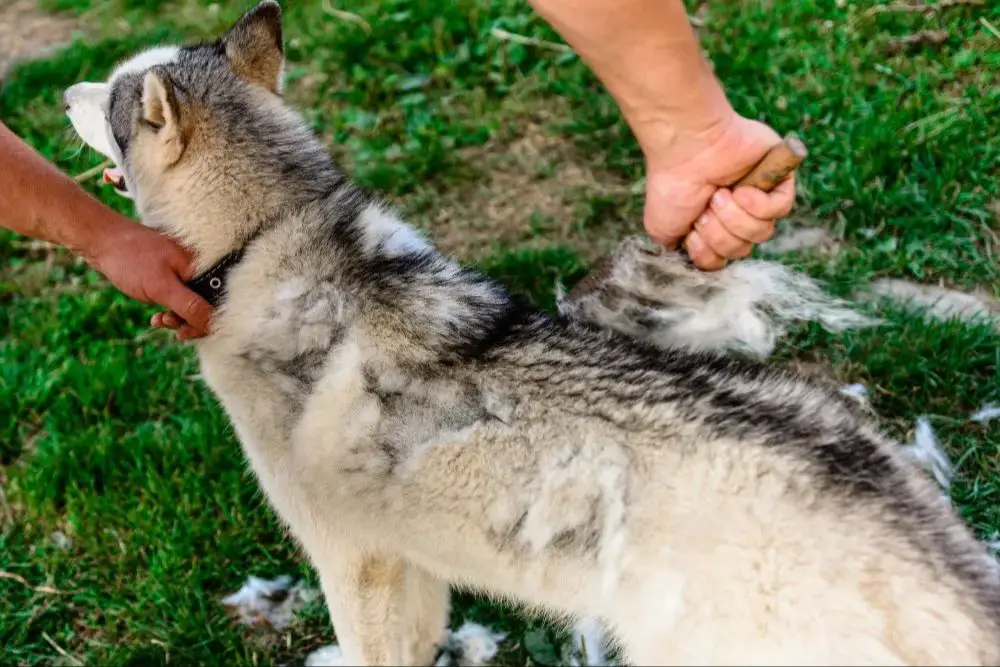Introduction
Shedding is a normal process in dogs where they lose old or damaged hair to allow new hair to grow in. The shedding process happens continuously but can intensify seasonally when dogs “blow” their coat and shed most of the old hair to make way for new growth. Some dogs shed more than others due to a variety of factors, including the breed type, coat genetics, environment/season, gender, health, and diet.
Certain breeds are considered heavy shedders due to their thick double coats that help protect them from cold temperatures. Breeds like Labrador Retrievers, German Shepherds, Siberian Huskies, and Great Pyrenees tend to shed more as their dense undercoats blow out seasonally. Gender can also influence shedding, with unaltered females shedding more than males. Environmental factors like temperature, humidity, and daylight hours trigger heavier shedding in preparation for seasonal coat changes. Overall health, skin conditions, poor nutrition, and stress can also increase shedding.
#20 – Labrador Retriever
The Labrador Retriever is one of the most popular family dogs, but also one of the worst shedders. Labs shed year-round and “blow” their undercoats twice a year, resulting in excessive shedding during spring and fall. Their short, dense coat releases a ton of dander and hair that ends up all over your furniture, clothing, and floors.
According to the Labrador Retriever Club, Labs shed “twice a year in handfuls” and need to be brushed daily during shedding seasons to control the amount of hair they release. The retriever origins of the Labrador make its coat water-resistant, which is great for the dog but not so much for keeping fur off your stuff.
Black Labs tend to shed a bit more than yellow or chocolate Labs. But all colors will cover your home in fur tumbleweeds if not brushed frequently. Be prepared with a good vacuum, lint rollers, and patience if you welcome a Lab into your home. Daily brushing and bathing during shed seasons can help reduce the volume of hair released inside.

Sources: https://www.snowypineswhitelabs.com/blog/how-to-reduce-shedding-in-labs/
#19 – German Shepherd
German Shepherds are one of the most popular dog breeds and for good reason – they are intelligent, loyal, and protective. However, this breed is also known for its constant shedding, ranking high on the list of worst shedding dogs.
German Shepherds have a double-coat that consists of a dense, soft undercoat and a thicker outer coat. They shed heavily during seasonal changes when they “blow” their undercoat to adapt to the warmer or cooler temperatures. Their shedding is especially prolific during the spring and fall months, though they tend to shed year-round as well (https://k-9dryers.com).
To manage a German Shepherd’s heavy shedding, regular brushing is essential to remove loose hairs and prevent mats. Bathing and grooming during peak shedding seasons can also help. Using a de-shedding tool can make a big difference in controlling all the fur flying around the house. Keeping their skin healthy with omega fatty acid supplements supports the regrowth of a lush winter or summer coat (https://vetgenpharmaceuticals.com).

WhileGerman Shepherds shed frequently, their wonderful temperaments and trainability make them a popular choice for many dog owners willing to take on the challenge of managing the fur. With some simple grooming techniques and fur clean-up, German Shepherd lovers find the constant sweeping and vacuuming required to live with this breed worth it.
#18 – Siberian Husky
The Siberian Husky is a beautiful, wolf-like sled dog originating from Siberia. They were bred by the Chukchi people to pull heavy sleds over long distances in frigid Arctic climates. Huskies have very thick double coats that keep them warm in the freezing temperatures. However, this luxurious coat comes at a price – heavy shedding.
Huskies blow their coats twice a year and shed heavily year-round. Their topcoat and undercoat consist of short fine hairs that come loose very easily. Owners need to be prepared for copious amounts of hair floating around the house and embedded in furniture and clothing. Daily brushing is a must during shedding season.
Frequent bathing and brushing can help reduce some shedding. Using a de-shedding tool specifically designed for double coated breeds like the Husky can make a big difference as well. But for the most part, shedding is just part of owning this breed. As long as you don’t mind constant vacuuming, lint rolling, and covering your clothes in dog hair, the loyal and affectionate Siberian Husky can make a great family pet.
Check out this video for grooming tips to manage a Husky’s shedding: The Best Brushes for Huskies
#17 – Great Pyrenees
The Great Pyrenees is a majestic giant breed known for its imposing stature and flowing white coat. Originally bred to guard livestock in the Pyrenees Mountains between France and Spain, these dogs have thick double coats that protected them from the elements while living outdoors.
Unfortunately, all that hair also ends up all over your furniture and floors. Great Pyrenees are one of the highest shedding breeds, losing hair year-round. Their undercoat sheds heavily during the spring and fall to make way for new growth. Daily brushing can help control loose hair, but you’ll still end up with tumbleweeds of fur rolling across your floors.
Great Pyrenees also shed heavily as puppies while growing their adult coats. Their thick fur comes at a price – be prepared for lots of hair and grooming if you welcome one of these giants into your home. But their patient loyal nature makes them outstanding companions for the right owner.
According to Great Pyrenees Dog Breed Information – American Kennel Club, their weather-resistant double coat requires weekly brushing and sheds heavily, especially in the spring and fall.
#16 – Akita
Akitas are known for their fierce loyalty and courage, but also for being heavy shedders. As a double-coated breed originally from Japan, Akitas shed their undercoat profusely twice a year during shedding seasons. While their daily shedding may be manageable, their blowouts can cover your home in tufts of fur.
According to https://petchao.com/akita-shedding/, Akitas shed year-round but have two heavy shedding seasons annually when they “blow” their undercoat. Their shedding can seem excessive during this time. Regular grooming and bathing can help remove loose hair and keep shedding under control.
Since Akitas have a thick double coat adapted for cold weather, they shed heavily as the seasons change. Their blowouts prepare their coat for warm or cold temperatures. Daily brushing when they are blowing their coat can help manage the hairy situation.
#15 – Alaskan Malamute
The Alaskan Malamute is a powerful dog originally bred for endurance and strength, able to pull heavy loads over long distances in the harsh Arctic climate. As a Nordic dog breed, the Alaskan Malamute has a thick, dense double-coat that keeps it warm in frigid temperatures.
This double-coat leads to intense seasonal shedding. As the seasons change, Malamutes will blow their undercoat, shedding massive amounts of fur. Owners can find tufts of fur all over the house during this heavy shedding season. Daily brushing when they are shedding can help control loose hair, but there will still be copious amounts ending up on your clothes and furnishings.

Their long guard hairs and wooly undercoat make the Malamute one of the top shedding breeds. Owners need to be prepared for the fluffy fur tumbleweeds and drifts of hair that will take over their homes when this breed blows its coat. The amount of hair they shed can be a nuisance for those not prepared for the ongoing grooming and clean-up required after living with this breed.
#14 – Collie
Collies are beautiful herding dogs that are known for their lush coats. This is part of what makes them such great herding dogs, as their double coats provide insulation and water resistance. However, all that lovely fur comes at a cost – collies shed heavily year-round and blow their coats seasonally. Without diligent brushing, collie owners can expect tumbleweeds of hair rolling across their floors.
Frequent brushing with a slicker brush is a must for this breed. Daily brushing when they are heavily shedding is ideal to keep up with all their hair. Their thick undercoat needs to be thinned out and dead hairs removed to control shedding. Many owners find using an undercoat rake very helpful as well. Trimming and bathing can also help minimize shedding. While collies will never be truly low-shedding dogs, with consistent grooming their hair can be managed.
For owners willing to put in the time and elbow grease to groom them, collies are wonderful dogs. Their loyalty, intelligence and beauty make them excellent companions. But prospective owners should be prepared for the reality of owning a heavy shedder before bringing one of these dogs home.
Sources: Smooth Coat Collie Rescue
#13 – Chow Chow
The Chow Chow is an ancient Chinese dog breed known for its fluffy, dense double coat. This breed is considered to be a moderate to heavy shedder, especially during the seasonal shedding periods of spring and fall. According to https://a-z-animals.com/blog/do-chow-chows-shed/, Chow Chow owners often report heavy shedding from their dogs during these seasonal coat blows when they transition between their winter and summer coats.
The Chow’s thick double coat is comprised of a coarse outer coat and a soft, wooly undercoat. They will shed small amounts of fur each day, but the heaviest shedding occurs when they blow their undercoat twice a year. Without regular brushing and grooming during these periods, Chow Chows can leave large clumps of fur all over the home, according to https://www.petplan.co.uk/pet-information/dog/breed/chow-chow/. Their profuse seasonal shedding makes the Chow Chow one of the top heavy shedding dog breeds.
#12-#1 – The Top 12
The top 12 worst shedding dog breeds are the ultimate shedders. From dense undercoats to loose hairs, these pups seem to have fur flying everywhere. If you’re looking for a low maintenance coat, these breeds are not for you.

#12 – Saint Bernard. Saint Bernards have a long, dense, double coat that sheds heavily, especially during seasonal changes. Their ample coat keeps them warm in cold climates, but requires vigilant grooming.
#11 – Old English Sheepdog. Old English Sheepdogs have a long, shaggy double coat prized for its protective qualities. But expect copious shedding and grooming to manage tangles and mats.
#10 – Samoyed. The Samoyed’s thick, white double coat sheds heavily year-round and blows coat seasonally, requiring daily brushing to control loose fur.
#9 – Newfoundland. The Newfoundland’s double coat has coarse guard hairs and a dense, wooly undercoat that sheds heavily and needs frequent brushing.
#8 – Great Pyrenees. Great Pyrenees have a long, thick, double coat that sheds heavily, especially during seasonal changes when they blow their undercoats.
#7 – Golden Retriever. Golden Retrievers have lush, feathery coats prone to year-round shedding and seasonal blowing of the undercoat.
#6 – Bernese Mountain Dog. Bernese Mountain Dogs have a thick tricolor coat with seasonal heavy shedding compounded by a longer annual shedding cycle.
#5 – German Shepherd. German Shepherds have a double coat with seasonal heavy shedding that requires frequent brushing to control loose hair.
#4 – Siberian Husky. Siberian Husky coats are dense with soft undercoats that shed heavily year-round, increasing in spring and fall.
#3 – Akita. Akitas have a thick double coat that sheds heavily, especially during seasonal changes. Their grooming needs are demanding.
#2 – Alaskan Malamute. Alaskan Malamutes have a dense, thick double coat that sheds heavily year-round, requiring vigilant grooming.
#1 – Chow Chow. The Chow Chow’s incredibly dense double coat sheds heavily year-round. Their profuse coat demands extensive grooming.